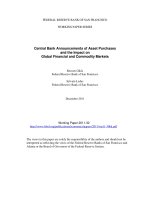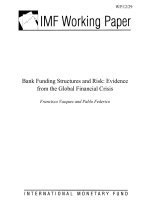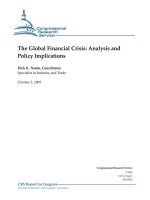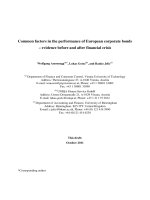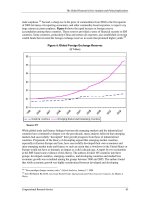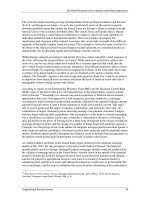joyce - the imf and global financial crisis; phoenix rising (2013)
Bạn đang xem bản rút gọn của tài liệu. Xem và tải ngay bản đầy đủ của tài liệu tại đây (3.23 MB, 263 trang )
The IMF
and Global
FInancIal crIses
Joyce
The IMF
and Global FInancIal crIses
Joseph P. Joyce
Praise for
The IMF and Global Financial Crises
“Joseph Joyce has written a masterful book tracing the history of the IMF from inception
to its current place in the international financial system. But The IMF and Global Financial
Crises is much more than a history. In an engaging yet clear fashion, Joyce explains the gen-
eses of financial crises, and why the functioning of the global economy requires an institu-
tion like the IMF. This book is sure to become the definitive work on this critically important
issue.”
– Menzie Chinn, University of Wisconsin–Madison
“Santayana reminds us that ‘Those who cannot remember the past are condemned to repeat
it.’ Joseph Joyce’s book provides a ready mnemonic. The International Monetary Fund is the
focal point of this work, and Joyce shows us both the strengths and the weaknesses of this
institution as an agent of stability in the volatile world financial markets. This will be an
important addition to your financial-crisis bookshelf.”
– Patrick Conway, University of North Carolina
“In this book, Joseph Joyce surveys the role of the International Monetary Fund in overseeing
international finance since the 1940s. Joyce’s clear, compelling analysis goes beyond this to
provide an informative, incisive history of modern international finance more generally. The
IMF and Global Financial Crises is an accessible, comprehensive, and fair-minded review
of the history, structure, and functioning of the contemporary international financial order.”
– Jeffry Frieden, Harvard University
“Joseph Joyce’s book is a tour de force. Unlike other works on the IMF this analysis weaves
together theory and practice from economics and political science with larger concerns over
the ways in which international organizations can influence domestic policies of member
states. Professor Joyce has produced a volume that will be an important reference for academ-
ics and policy makers alike.”
– David Leblang, University of Virginia
“Joe Joyce has written a concise yet lucid history of the IMF that focuses on its evolving role
in a world of increasing financial fragility. This volume fills a real pedagogical gap, and any-
one who teaches about the international monetary system, or wishes to learn about it, will be
in the author’s debt.”
– Maurice Obstfeld, University of California, Berkeley
“Joe Joyce has produced a concise review of the IMF’s sixty-five-year evolution. The book is
comprehensive, informative, and provocative.”
– Edwin (Ted) M. Truman, Senior Fellow,
Peterson Institute for International Economics
Joseph P. Joyce is a Professor of Economics at
Wellesley College.
Cover image: © Toria / Shutterstock.com
Cover design by David Levy
Phoenix Rising?
THE IMF AND GLOBAL FINANCIAL CRISES
e International Monetary Fund's response to the global crisis of 2008–9
marked a signi cant change from its past policies. e IMF provided relatively
large amounts of credit quickly with limited conditions and accepted the use of
capital controls. is book traces the evolution of the IMF’s actions to promote
international nancial stability from the Bretton Woods era through the most
recent crisis. e analysis includes an examination of the IMF’s crisis manage-
ment activities during the debt crisis of the 1980s, the upheavals in emerging
markets in the 1990s and early 2000s, and the ongoing European crisis. e
dominant in uence of the United States and other advanced economies in the
governance of the IMF is also described, as well as the replacement of the G7
nations by the members of the more inclusive G20, which have promised to
give the IMF a role in their mutual assessment of policies while undertaking
reforms of the IMF’s governance.
Joseph P. Joyce is a professor of economics at Wellesley College and serves as the
faculty director of the Madeleine Korbel Institute for Global A airs. Professor
Joyce’s research deals with issues in nancial globalization. He has published
articles in many journals, including the Journal of International Money and
Finance , Open Economies Review , Review of International Economics , Journal of
Development Economics , and Economics & Politics, and he is a member of the
Editorial Board of the Review of International Organizations . He received his
Ph.D. in economics from Boston University.
e IMF and Global Financial Crises
Phoenix Rising?
J O S E P H P . J O Y C E
Wellesley College
Department of Economics
Cambridge, New York, Melbourne, Madrid, Cape Town,
Singapore, S ã o Paulo, Delhi, Mexico City
Cambridge University Press
32 Avenue of the Americas, New York , NY 10013-2473, USA
www.cambridge.org
Information on this title: www.cambridge.org/9780521874175
© Joseph P. Joyce 2013
is publication is in copyright. Subject to statutory exception
and to the provisions of relevant collective licensing agreements,
no reproduction of any part may take place without the written
permission of Cambridge University Press.
First published 2013
Printed in the United States of America
A catalog record for this publication is available from the British Library.
Library of Congress Cataloging in Publication data
Joyce, Joseph P.
e IMF and global nancial crises : Phoenix rising? / by Joseph P. Joyce.
p. cm.
Includes bibliographical references and index.
ISBN 978-0-521-87417-5 (hardback)
1. International Monetary Fund. 2. Financial crises. 3. International nance.
4. Global Financial Crisis, 2008–2009. 5. International Monetary Fund –
Developing countries. I. Title.
HG3881.5.I58J69 2013
332.1′52–dc23 2012023656
ISBN 978-0-521-87417-5 Hardback
Cambridge University Press has no responsibility for the persistence or accuracy of URLs
for external or third-party Internet Web sites referred to in this publication and does not
guarantee that any content on such Web sites is, or will remain, accurate or appropriate.
e phoenix hope can wing her ight
ro’ the vast deserts of the skies,
And still defying fortune’s spite,
Revive, and from her ashes rise.
Miguel De Cervantes,
Don Quixote (Motteux, trans.)
vii
List of Figures, Tables, and Boxes page x
P r e f a c e xiii
A c k n o w l e d g m e n t s xvii
List of Abbreviations xix
1 . I n t r o d u c t i o n 1
1.1 IPGs and Financial Stability 4
1.2 IGOs and the IMF 8
1.3 Principals and Agents 10
1.4 Overview 13
2. Bretton Woods 19
2.1 New Order 20
2.2 Administrative Arrangements 24
2.3 Adjustment versus Finance 26
2.4 Collapse of Bretton Woods 31
2.5 IMF and Bretton Woods: Appraisal 32
3 . T r a n s i t i o n s 3 5
3.1 New Responsibilities 36
3.2 Euromarkets 40
3.3 Recycling 42
3.4 New Organizations 47
3.5 IMF and the Nonsystem: Appraisal 49
4 . e Debt Crisis 52
4.1 Crisis Emergence 53
4.2 Crisis Manager 55
4.3 Program Breakdowns 58
Contents
Contents
viii
4.4 Crisis Resolution 62
4.5 Basel I 67
4.6 IMF and the Debt Crisis: Appraisal 69
5. Global Finance Redux 72
5.1 Resurgence of Capital Flows 73
5.2 IMF Programs and Capital Decontrol 76
5.3 Catalysis 81
5.4 New Amendment 83
5.5 IMF and Financial Liberalization: Appraisal 86
6. Currency Crises 88
6.1 ERM 89
6.2 IMF and the ERM Crisis: Appraisal 92
6.3 Mexico: Crisis 96
6.4 Mexico: A ermath 100
6.5 IMF and Mexico: Appraisal 102
7 . e Widening Gyre 105
7.1 East Asia 106
7.2 IMF and East Asia: Appraisal 115
8. Fiscal Follies 120
8.1 Russia 121
8.2 IMF and Russia: Appraisal 124
8.3 Brazil 125
8.4 Argentina 127
8.5 IMF and Argentina: Appraisal 132
9. Lessons Learned 134
9.1 Reforms 135
9.2 International Lender of Last Resort 139
9.3 FSF and Basel II 143
9.4 Reserves and Regional Arrangements 148
10. e Great Recession 153
10.1 Global Imbalances 154
10.2 Premonitions 161
10.3 Impasse 164
10.4 Implosion 167
10.5 IMF and the Great Recession: Appraisal 177
Contents
ix
11. e World Turned Upside Down 181
11.1 Debt Again 182
11.2 Integration or Autonomy? 188
11.3 What Is to Be Done? 191
Appendix: IMF Data 197
R e f e r e n c e s 201
I n d e x 227
x
Figures
4.1. Debtors and Lenders: Chicken Game page 56
4.2. Debt of Heavily Indebted Countries: 1982–1990 63
4.3. Capital Flows to Developing Economies and Emerging
Markets: 1980s 64
5.1. Capital Flows to Developing Economies and Emerging
Markets: 1990s 75
9.1. Foreign Reserves of Emerging Markets: 1997–2009 149
10.1. Real GDP Growth: 2000s 155
10.2. In ation: 2000s 156
10.3. Capital Flows to Developing Economies and Emerging
Markets: 2000s 157
10.4. Current Accounts of Advanced Economies: 2000–2009 158
10.5. Current Accounts of Developing Economies and Emerging
Markets: 2000–2009 159
10.6. Real GDP Growth Rates of Advanced Economies: 2008–2011 175
10.7. Real GDP Growth Rates of Developing Economies and
Emerging Markets: 2008–2011 176
11.1. Government Gross Debt of Selected Advanced Economies:
2007–2015 184
11.2. Government Gross Debt of Advanced Economies and
Emerging Markets: 2007–2015 187
A.1. Size of IMF Membership and U.S. Voting
Share: 1950–2010 197
A.2. Arrangements Approved: 1970–2011 198
A.3. Amounts Committed under Lending Arrangements:
1970–2011 199
List of Figures, Tables, and Boxes
Figures, Tables, and Boxes
xi
Tables
3.1. Oil Exporters’ Revenues 43
3.2. Main Lender Banks to Developing Nations: 1970s 45
3.3. Bank Loans to Developing Nations: 1977–1982 46
4.1. Economic Conditions in Heavily Indebted Countries 65
5.1. New Members Post–1973 77
6.1. Mexico: 1991–1996 97
7.1. ailand: 1994–1999 108
7.2. Indonesia: 1994–1999 109
7.3. Philippines: 1994–1999 111
7.4. South Korea: 1994–1999 112
7.5. Malaysia: 1994–1999 113
8.1. Russia: 1995–2000 122
8.2. Brazil: 1995–2000 126
8.3. Argentina: 1997–2002 128
8.4. Turkey: 1997–2002 131
9.1. Standards for Sound Financial Systems 145
10.1. IMF Stand-By Arrangements Post–September 2008 170
A.1. Managing Directors 199
A.2. Quota Reviews 200
Boxes
2.1. IMF Article of Agreement I 22
2.2. Financial Programming 28
3.1. IMF’s Revised Article of Agreement IV 38
4.1. First-Generation Model of Currency Crises 60
6.1. Second-Generation Model of Currency Crises 94
xiii
e year 1973 was a transitional one for the global economy. Attempts to
revive the Bretton Woods system of xed exchange rates were abandoned;
increases in oil prices led to the occurrence of higher prices and falling out-
put, which was labeled “stag ation”; and it was the last year that the U.S.
government maintained restrictions on capital ows. ere was one other
event of somewhat lesser signi cance: my graduation from Georgetown
University’s School of Foreign Service, where I developed an interest in
international economics. A er two years of work in New York, I entered
Boston University’s graduate program in economics. I subsequently was
fortunate to receive an appointment to the faculty at Wellesley College,
where I have remained ever since.
I began my professional academic life, therefore, during the post–Bretton
Woods era of currency regime and nancial liberalization. e removal of
capital controls by the United States was followed by nancial deregula-
tion in other developed economies in the 1970s, and by many Asian and
Latin American countries during the following decades. Capital ows rap-
idly expanded, and by the end of the century it was possible to refer to the
integration of nancial markets across borders as the latest manifestation of
globalization (Mishkin 2006 ). But it was also a period of economic volatil-
ity and upheaval, which included the debt crisis of the 1980s, the nancial
crises in the emerging markets of the 1990s, and, most recently, the global
crisis of 2008–9.
At the center of all these events was the International Monetary Fund. I
was drawn to the study of the IMF because it provided a focus on the twists
and turns in the international economy. e IMF was o en the subject of
criticism: sometimes misinformed and unfair, sometimes well deserved.
In my research I sought to substantiate the record of the IMF’s activities
and their impact. In one of my rst postdissertation research papers, I
Preface
Preface
xiv
investigated the economic characteristics of countries that sought the IMF’s
assistance. Subsequent works dealt with the repeated occurrence of IMF
programs, the implementation of the policy conditions attached to them,
the impact of Fund programs on poverty, the IMF’s status as a provider of
public goods, and the IMF’s stance on capital account deregulation. In all of
these studies I learned something about the IMF and about the economic
conditions of its member countries.
Like others, I was caught o guard by the outbreak of the nancial crisis
in 2008 but greatly interested by the response of the IMF. e Fund, which
had laid o sta members earlier in the decade because of a lack of lend-
ing programs, answered its members’ requests for assistance by providing
large amounts of credit with relatively limited and focused conditionality.
e IMF was labeled a “phoenix” and seen as “back in the game,” and its
rapid and energetic reaction allowed its reputation to recover from the criti-
cisms it had received for its previous crisis management activities, particu-
larly those undertaken during the East Asian crisis of 1997–8. But the IMF
was soon involved in the European debt crisis, while the emerging market
nations pressed the IMF to investigate the role of capital controls in con-
taining the impact of nancial ows.
is book examines the IMF’s attempts to promote the international
public goods of economic and nancial stability from the end of the
Bretton Woods system in 1973 through the 2008–9 crisis and the subse-
quent events in Europe. is account demonstrates how the IMF changed
its policy prescriptions in response to the nancial turbulence of this era.
e IMF learned to respond more quickly when necessary and to distin-
guish between crisis conditions that require major adjustments in domestic
policies and those that are due to external shocks that should be nanced.
is shi matched a growing awareness of the instability that can arise in
nancial sectors and an evolution in the IMF’s position on the advantages
and disadvantages of unregulated capital accounts.
In telling this story, this book also surveys the IMF’s relationship as an
agent with its principals, the member governments. For many years the
IMF’s membership was divided among the advanced (or upper-income)
economies, emerging market (or middle-income) nations, and developing
(or lower-income) countries. is strati cation was not rigid, and coun-
tries did rise and fall among the categories. But during the post–Bretton
Woods era the advanced economies that dominated the IMF and other
international agencies did not need to borrow from the Fund, while the
emerging markets with much less clout were forced to turn to the IMF for
credit whenever they experienced one of their recurrent nancial crises.
Preface
xv
e IMF’s poorer members were cut o from private nancial ows and
depended upon the IMF and other multilateral agencies for assistance.
Consequently there was friction between those nations that directed the
IMF’s governance and those that borrowed from it.
e nancial shock that shook the world economy in 2008, however,
originated in the United States, and the advanced economies were particu-
larly hard hit by the ensuing crisis. Moreover, these nations could no longer
claim any superiority in their regulatory systems once the activities of the
“shadow” banking systems came to light. e emerging markets, on the
other hand, su ered only mild slowdowns before their growth resumed its
impressive pace. e change in the relative positions of the IMF’s members
was made clear when the G7 group of nations transferred its role as the
chief forum for international economic policy making to the G20, which
includes many emerging markets. is changeover was accompanied by
promises to overhaul the governance of the IMF.
e IMF, which for thirty- ve years sought to nd its place in the era of
nancial globalization, must reinvent itself again. No one expects a return
to a Bretton Woods–style system of universal exchange rate and capital
account regimes. But the transition to a world where the advanced econo-
mies cope with mounting debt and the emerging markets and developing
economies seek to continue their rapid growth without exposing them-
selves to nancial volatility will require a reappraisal of the international
monetary system by the IMF and its members as profound as that which
occurred at the Bretton Woods conference in 1944. My hope is that this
book contributes to that debate.
xvii
is work has bene ted from conversations with many colleagues. Among
those who have discussed these issues with me are Rawi Abdelal, Je rey
Chwieroth, Onno de Beaufort Wijnholds, Domenico Lombardi, Kenneth
A. Reinert, Lorenzo Bini Smaghi, omas Willett, and Ngaire Woods.
Special thanks are due to my former coauthors Graham Bird, Ilan Noy, Raul
Razo-Garcia, and Todd Sandler. Scott Parris of Cambridge University Press
has shown great patience as this book has gone through multiple dra s, and
an exceptional reader explained how to separate the wheat from the cha .
Several Wellesley College students, including Virginia Ritter, Leslie Shen,
and SuiLin Yap, provided valuable research assistance.
e completion of this book owes much to the patience of my wife,
Catherine Clark. She tolerated without reproach many hours of my absence
while maintaining the household. My children, Caroline and Alison, also
accepted as part of a normal childhood their father’s many disappearances
to work on the book. I am very fortunate in having a wonderful and sup-
portive family.
Acknowledgments
xix
ASEAN Association of Southeast Asian Nations
BCBS
Basel Committee for Banking Supervision
BIS
Bank for International Settlement
CCL
Contingent Credit Line
CMI
Chiang Mai Initiative
CMIM
Chiang Mai Initiative Multilateralization
CPSS
Committee on Payments and Settlement Systems
EC
European Community
ECB
European Central Bank
EFF
Extended Fund Facility
EFSF
European Financial Stability Facility
EMS
European Monetary System
ERM
Exchange Rate Mechanism
ESAF
Enhanced Structural Adjustment Facility
ESF
Exogenous Shocks Facility
EU
European Union
FCL
Flexible Credit Line
FDI
Foreign Direct Investment
FSAP
Financial Sector Assessment Program
FSB
Financial Stability Board
FSF
Financial Stability Forum
FSSA
Financial System Stability Assessment
G5
Group of Five
G7/8
Group of Seven/Eight
G10
Group of Ten
G20
Group of Twenty
G24
Group of Twenty-Four
G77
Group of Seventy-Seven
Abbreviations
Abbreviations
xx
GAB General Arrangements to Borrow
GFSR
Global Financial Stability Report
GNI
Gross National Income
H A P A
High Access Precautionary Arrangement
IAIS
International Association of Insurance Supervisors
IEO
Independent Evaluation O ce
IFI
International Financial Institution
IFIAC
International Financial Institution Advisory Commission
IGO
Intergovernmental Organization
IMF
International Monetary Fund
IMFC
International Monetary and Financial Committee
IOSCO
International Organization of Securities Commissions
IPG
International Public Good
LIBOR
London Interbank O er Rate
NAB
New Arrangements to Borrow
OECD
Organisation for Economic Co-operation and Development
OPEC
Organization of Petroleum Exporting Countries
PRGF
Poverty Reduction and Growth Facility
SAF
Structural Adjustment Facility
S B A
Stand-By Arrangement
S D R
Special Drawing Rights
SDRM
Sovereign Debt Resolution Mechanism
SLF
Short-Term Liquidity Facility
SRF
Supplemental Reserve Facility
WEO
World Economic Outlook
1
1
Introduction
Among the many surprising features of the global nancial crisis of 2008–9
was the emergence of the International Monetary Fund (IMF) as a leading
player in the response to what has become known as the “Great Recession.”
e news that the IMF was “back in business” was remarkable in view of the
deterioration of the IMF’s reputation a er the crises of the late 1990s and
the decline in its lending activities in the succeeding decade. e IMF had
been widely blamed for indirectly contributing to the earlier crises by advo-
cating the premature removal of controls on capital ows, and then impos-
ing harsh and inappropriate measures on the countries that were forced to
borrow from it. e number of new lending arrangements approved by the
IMF had fallen from twenty-six in 2001 to twelve in 2007 ( Figure A.2 ), and
all but two of the latter went to the IMF’s poorest members, which had little
access to private sources of nance.
Moreover, the IMF, the intergovernmental organization assigned the
task of promoting international economic and nancial stability, initially
had no direct role in dealing with the crisis. Finance ministers and central
bank heads in the United States and Western Europe, where the nancial
institutions most a ected by the crisis were located, sought to contain its
impact by easing credit conditions and rescuing distressed nancial institu-
tions. e IMF was relegated to the sidelines as government o cials in the
advanced economies coordinated their responses to the crisis.
All this changed in the fall of 2008, however, a er a series of nancial
failures in the United States. Global nancial markets froze as lenders drew
back in response to the uncertainty over which borrowers were still viable.
e collapse of the nancial system led to an economic contraction that
spread outside the original group of crisis countries. World trade fell and
capital ows slowed and in some cases reversed, as nervous banks, rms,
and investors sought to reallocate their money to safer venues.
Introduction
2
e nancial crisis also triggered an upheaval in international economic
governance. e Group of Seven/Eight (G7/8) was replaced by the Group
of Twenty (G20) nations as the appropriate forum for international eco-
nomic coordination, and the leaders of the broader set of countries met
in Washington, D.C., to formulate a joint response to the crisis.
1
ey
announced their support of the IMF and agreed to boost its nancial
resources signi cantly so that the Fund could meet the demands for its
assistance . In response, the IMF provided loans to a range of countries,
including the Ukraine, Hungary, Iceland, and Pakistan ( Chapter 10 ). In
addition, the IMF restructured its lending programs, cutting back in many
cases the policy conditions attached to its loans and increasing the amount
of credit a country could obtain. e Fund also introduced a new credit line
without conditions for countries with records of stable policies and strong
macroeconomic performance. Moreover, the IMF pledged to work with
national governments and other international organizations a er the cri-
sis receded to continue the economic recovery and improve the regulation
of global nancial markets. Consequently, many commentators hailed the
rejuvenated IMF as a “phoenix” (Beattie 2010 ).
is book contends that the IMF’s response to the Great Recession marked
a signi cant break from its policies during previous global nancial crises.
ese had taken place during an era when the IMF’s membership was strat-
i ed by income and whether or not a country borrowed from the Fund.
2
I n
addition, the IMF had actively encouraged the deepening and widening of
global nance. e IMF’s previous responses to nancial crises, therefore,
re ected the dominance of its upper-income members as well as an ideo-
logical consensus in favor of nancial globalization. Its lending programs
had sought to restore countries in crisis to the global capital markets.
1
e members of the G7 are Canada, France, Germany, Italy, Japan, the United Kingdom,
and the United States. e G7 became the Group of Eight (G8) when Russia joined in 1997.
However, the G7 nance ministers continue to meet separately from the Group of Eight
national leaders. e G20 includes the countries of the Group of Eight and Argentina,
Australia, Brazil, China, India, Indonesia, Korea, Mexico, Saudi Arabia, South Africa,
Turkey, and the European Union. See Chapter 3 on the formation of the G7 and Chapter
10 on the G20.
2
e World Bank classi es countries by their gross national income (GNI) per capita. In
2011 low-income nations were those with a GNI of $1,005 or less; middle-income coun-
tries those with GNI per capita of $1,006 to $12,275; and upper-income countries those
with GNI per capita of more than $12,276 or higher. e middle-income countries were
divided into lower and upper middle-income nations at a GNI per capita of $3,975. ese
thresholds have risen over time, and countries have moved among categories. e three
main groups correspond to what we call the advanced economies, the emerging markets,
and the developing countries.
Introduction
3
But the crisis upended those circumstances. e shock to the global
economy originated in the upper-income countries, and the recovery of
many of these nations has been relatively sluggish. e emerging econo-
mies, on the other hand, rebounded from the global economic contrac-
tion more quickly, in turn contributing to the recovery of the developing
nations. Moreover, the crisis demonstrated that nancial instability can be
a systemic condition, con rming the need for prudent oversight and the
regulation of nancial markets and capital ows.
While the Great Recession provided the IMF with an opportunity to dem-
onstrate that it has learned the lessons of its past mistakes, there are funda-
mental economic and political transformations under way that will a ect
the ability of the IMF to counter future nancial instability. e replace-
ment of the dominance of the G7/8 by the G20 should lead to a more equi-
table governance structure within the IMF, although inertia has slowed the
pace of reform. Moreover, the European debt crises pose new challenges to
the IMF. e Fund is caught in the cross re among Eurozone governments
and their citizenries over how to deal with members in nancial distress.
Fiscal burdens will mount in other advanced economies with aging popula-
tions and rising health care and public pension costs. e emerging market
governments, which face a di erent set of challenges as they seek to con-
tinue their rapid growth, will be suspicious of IMF programs if these appear
to be less demanding than those extended during earlier crisis periods.
is book examines the evolution of the policies and programs of the IMF
with respect to the global nancial markets and crises in these markets.
3
We
show how the IMF’s activities during the period of 1973–2008 re ected the
in uence of its dominant members as well as the IMF’s own commitment
to capital market integration and evaluate the e ectiveness of the IMF in
its roles as crisis preventer and crisis manager. e challenges of the future
are also addressed, as well as the steps the IMF must take to solidify its
reputation.
e consequences of the changes in the IMF’s own governance extend
beyond the IMF itself. Similar relationships between the IMF and its mem-
bers exist in other international agencies, where the need to accommodate
the aspirations of the emerging market countries must be met. We draw
3
Other research deals with related aspects of the IMF’s work. Histories of the IMF include
works by Boughton (2001b) and James ( 1996 ). Bird ( 2007 ) has provided an overview of
the professional literature. Political analyses of the IMF’s activities have been undertaken
by Copelovitch ( 2010 ), Stone ( 2011 ), Vreeland ( 2007 ), and Woods ( 2006 ). Boughton
and Lombardi ( 2009 ) o er an assessment of the IMF’s dealings with its low-income
members.
Introduction
4
upon agency theory to explain how the advanced economies exercised a
collective leadership to in uence the IMF and other multilateral agencies,
and how that control has been replaced by wider but perhaps less e ective
direction by the G20.
is account also illustrates the importance of viewing both economic
and nancial stability as international public goods. Financial stability was
once seen as an outcome or accompaniment of economic stability. But the
asset booms of the last decade, following the technology boom of the 1990s
and the Japanese property bubble of the preceding decade, demonstrated
that asset prices could veer for years from values justi ed by fundamen-
tal factors. e subsequent reversals have had serious consequences for
economic activity that persist over many years and extend over national
borders.
e remainder of this chapter presents a synopsis of the basic concepts
that will guide our analysis. e next section provides an overview of the
status of international economic and nancial stability as international
public goods (IPGs). It is followed by a description of the activities of inter-
governmental organizations (IGOs) such as the IMF. e following section
presents the theoretical perspectives of agency theory, which provides a
valuable perspective on the Fund’s relations with its member governments.
e last section contains an outline of the main arguments of the book.
1.1 IPGs and Financial Stability
Crises have been a constant of market capitalism – from the bursting of the British
South Sea bubble and the French Mississippi in 1720, . . . to the depressions of the
1870s and 1930s in the industrial economies, to the debt crises of middle-income
Latin American countries and low-income African countries in the 1980s, the col-
lapse of output in the formerly socialist economies in the 1990s, and the East Asian
nancial crisis in 1997–1998. (Easterly, Islam, and Stiglitz 2001 : 191)
e devastating impact and wide scope of the recent crisis provide ample
evidence of the status of nancial stability as an IPG. Public goods constitute
a type of market failure, as characterized by the features of nonexcludability
in their supply (once a good is provided, it is available to all) and nonrival-
ness in their consumption (a good can be used by more than one individual
simultaneously) (Olson 1965 , Cornes and Sandler 1996 ). Consumers have
no incentive to purchase an item if they think that others may pay its cost
and they can also enjoy it, a phenomenon known as “free riding.” A gov-
ernment, however, can compel its citizens to contribute to the provision of
a good that will bene t all.
